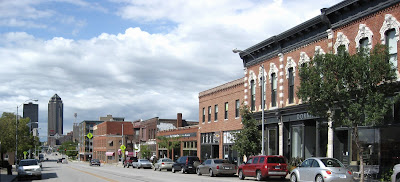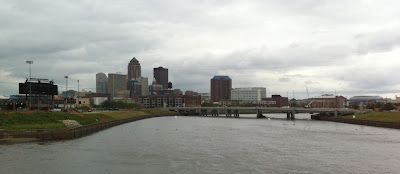




















Mr Sylvester
As a forward-thinking "authority" I feel as though the policies and
priorities exhibited by this station area and those preceding
represent what amounts to a baby step in the progression of
Albuquerque's built environment. After briefing through the
presentation and EIS it would appear that the foremost priority
within this plan lies in its ability to accommodate the automobile.
This priority is what has led us to the point we're at. As the
Railrunner is struggling to prove its value in tough economic times,
shouldn't it be a priority to maximize its potential to catalyze new
growth patterns and land use?
TONY - we are really trying to develop a station that balances auto and bus access. The station accommodates up to 8 buses, including those that use the bus bays on Montano. In the immediate future there really aren't plans for many more buses in the area (right now there are only 2). But - the station is designed to potentially evolve into a more "transit" accommodating facility, as well as to accommodate some built structures. One of the reasons to prioritize the auto is that folks in the neighborhood know the overflow conditions at El Pueblo, and the fact that for at least the immediate future, autos play the key role in access. The "we don't want people parking in our neighborhood" concern was one raised at the last public meeting.
Mixed-use
The footprint of the land within the proposal is large enough to
accommodate a mix of uses rather than just parking lots. Granted, the
parking lots are wonderfully designed as it's apparent someone has
had lots of practice. But with the station and its location near a
north 4th area planned for mixed-use, it would seem like a priority
would be to extend this mixed-use development to this area. Why not
build into the system a new population of users? I hate using other
cities as an example because people often become defensive and say
their city is so different. BUT, Seattle did a wonderful job creating
new urban villages at their stations, thus building automatic system
users. I'm not suggesting this model is a direct correlation as the
commuter rail is different from light-rail but it still provides
valuable lessons for station area planning. The RailRunner model is
built on a continued need for expanded parking lots (ie. Journal
Center) and nothing else. We're several years into this service and
TOD only exists in downtown ABQ and SF and it's limited at best.
TONY - We are working with the City to evaluate mixed use opportunities in the area, and to develop a framework plan to move ahead. While we see this as a vision of the future, auto access is key in the short term. We know that if someone drives to the station, cant find a parking place and misses their train, we will lose a transit rider. We have planned buses along Montaño to serve the station, but at this point there are few people residing in walking distance, and very limited bus access.
Stormwater
The paving over of our desert environment is leading to the
degradation of our region including that of contaminated water
runoff. I'm sure it was looked at but surely more could be done to
maximize onsite stormwater treatment. For 60 years we've piped
everything into our gutters. The result is larger and larger storm
events due to increased runoffs. Then we get things like giant holes
in the ground along our major gateways. (see Lomas & Broadway)
TONY - The landscaped areas running east and west will capture and retain water. While some stormwater will go into the storm drain, we are retaining as much as possible on site.
I'm assuming the Rapid Ride will be integrated with this stop. It
wasn't clear from what I briefed over.
TONY - Rapid Ride does not serve this area. The Transit District plans call for east bound and west bound Montaño buses from the station.
Lastly, the 2025 estimate for travel time from downtown ABQ to
downtown Santa Fe is 115 minutes? Right now it's close to 60minutes.
Using this figure to gauge the "efficiency" of the RailRunner system
is a poor litmus test that doesn't meet reality. This number does
little to help make the RailRunner competitive currently. Again, more
could be done.





 A brilliant graphic from the Infrastructurist. Unfortunately, me thinks our beautiful Duke City would resemble Houston. However, Rapid Ride, the RailRunner, and a stronger bicycling/pathway infrastructure are helping us to improve our repertoire. Now if we could just get our land use in order...
A brilliant graphic from the Infrastructurist. Unfortunately, me thinks our beautiful Duke City would resemble Houston. However, Rapid Ride, the RailRunner, and a stronger bicycling/pathway infrastructure are helping us to improve our repertoire. Now if we could just get our land use in order...







